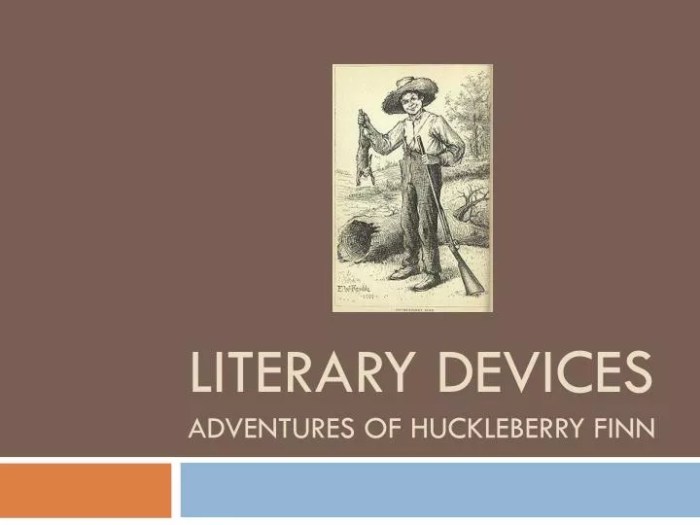Literary devices in Huckleberry Finn play a pivotal role in crafting a narrative that delves into the complexities of race, identity, and the search for freedom. Mark Twain’s skillful use of symbolism, irony, satire, humor, characterization, setting, and theme creates a rich tapestry that explores the contradictions and hypocrisies of American society.
Through the lens of these literary devices, Huckleberry Finn emerges as a poignant and enduring work that continues to resonate with readers today, offering insights into the human condition and the ongoing struggle for equality.
Symbolism

Symbolism plays a crucial role in Huckleberry Finn, enhancing the novel’s exploration of complex themes and conveying deeper meanings.
The Mississippi River
- The river symbolizes the journey of life, with its twists and turns representing the challenges and opportunities encountered along the way.
- It represents the boundary between the civilized world and the wilderness, highlighting the clash between societal norms and individual freedom.
- Its ever-changing nature reflects the fluidity of human identity and the search for self-discovery.
Jim’s Raft
- The raft symbolizes freedom and escape from the constraints of society.
- It represents the bond between Huck and Jim, who find solace and companionship in their shared journey.
- Its precarious nature reflects the fragility of their friendship and the dangers they face.
Use of Symbolism to Convey Race and Identity
Twain uses symbolism to explore the complexities of race and identity in the antebellum South.
- The contrast between Huck’s and Jim’s skin colors highlights the societal divide based on race.
- The raft becomes a symbol of equality, where racial differences are transcended through shared experiences.
- The river’s ever-changing nature reflects the fluidity of racial boundaries and the potential for transformation.
Irony

Irony is a key literary device used by Twain to expose hypocrisy and highlight the absurdities of society.
Contrast between Huck’s Perception of Jim and Society’s Views
- Huck’s initial prejudice against Jim is juxtaposed with his growing understanding of Jim’s humanity and dignity.
- This irony highlights the irrationality of societal racism and the power of individual experiences to challenge preconceived notions.
Exploration of Hypocrisy and Prejudice
- Twain satirizes the hypocrisy of characters who claim to be religious but act immorally.
- He uses irony to expose the double standards that exist in society, particularly in relation to race.
- The novel’s exploration of irony contributes to its powerful indictment of societal injustices.
Use of Irony to Create Humor and Highlight Absurdities
Twain’s use of irony often results in humorous situations that highlight the absurdity of certain characters and situations.
- The Duke and the Dauphin’s failed attempt to swindle the Wilks family is an example of ironic humor.
- The novel’s portrayal of the feud between the Grangerfords and the Shepherdsons satirizes the senselessness of violence.
Satire: Literary Devices In Huckleberry Finn

Twain uses satire to critique social norms and institutions, particularly those that perpetuate racism and inequality.
Targets of Twain’s Satire
- Racism and slavery are primary targets of Twain’s satire, which exposes their dehumanizing and unjust nature.
- He also satirizes religious hypocrisy, highlighting the gap between professed beliefs and actual behavior.
- Twain’s satire extends to political corruption and the pursuit of wealth at the expense of others.
Effectiveness of Satire in Conveying Twain’s Message
Twain’s satire is highly effective in conveying his message and provoking social change.
- It uses humor and wit to engage readers and make them receptive to the novel’s serious themes.
- The satire exposes the absurdity and injustice of certain societal practices, prompting readers to question their own beliefs and values.
- Twain’s satire has had a lasting impact on American literature and has contributed to the ongoing struggle for social justice.
Humor
Humor plays a significant role in Huckleberry Finn, lightening the tone of the novel while still addressing serious issues.
Types of Humor Used in the Novel, Literary devices in huckleberry finn
- Slapstick comedy is used to create physical humor, such as when Huck and Jim get into a fight with the Duke and the Dauphin.
- Irony is used to create humorous situations, such as when the townspeople believe Huck and Jim are ghosts.
- Wordplay and puns are also used to add humor to the novel.
Lightening the Tone of the Novel
Humor helps to lighten the tone of the novel, which deals with some heavy themes.
- It provides a break from the more serious moments and makes the novel more enjoyable to read.
- Humor allows Twain to make his points about racism and slavery in a more palatable way.
Making the Novel More Accessible and Engaging
Humor makes the novel more accessible and engaging for readers.
- It helps to draw readers into the story and keeps them interested.
- Humor makes the novel more relatable and allows readers to connect with the characters on a personal level.
FAQ Resource
What is the significance of the Mississippi River as a symbol in Huckleberry Finn?
The Mississippi River symbolizes both freedom and the journey towards self-discovery for Huck and Jim.
How does Twain use irony to highlight the hypocrisy of society?
Twain employs irony to contrast Huck’s perception of Jim as a human being with the societal views that dehumanize him.
What are the different types of humor used in Huckleberry Finn?
Twain incorporates slapstick, irony, and wordplay to create humor that lightens the tone while addressing serious issues.